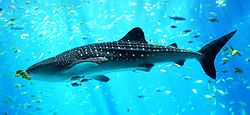
The whale shark, Rhincodon typus, is a slow-moving filter feeding shark and the largest of the living fish species. The largest confirmed shark is 41 feet long and the heaviest weighs more than 79,000 pounds. However, there are unconfirmed reports of whale sharks that are even larger.
 Courtesy photo / Here is a whale shark from the waters of Taiwan as shown here in the Georgia Aquarium in Atlanta.
Courtesy photo / Here is a whale shark from the waters of Taiwan as shown here in the Georgia Aquarium in Atlanta.This shark is the sole species of the genus Rhincodontidae. The species originated about 60 million years ago. The whale shark is found in tropical and warm oceans. It can live in the open sea with a lifespan of about 70 years.
Although whale sharks have very large mouths, they feed mainly, though not exclusively, on plankton, microscopic plants and animals. However, the TV program Planet Earth filmed a whale shark feeding on a school of small fish. The name "whale shark" comes from the fish's physiology; as large as a whale, it too is a filter feeder.
The species was distinguished in April 1828, following the harpooning of a 15-foot specimen in South Africa. Andrew Smith published a detailed description of the whale shark in 1849. The whale shark is not an efficient swimmer since it uses its entire body to attain an average speed of three miles per hour. Other fish use their tails to swim and go much faster.
The largest specimen of whale shark was caught in 1947 in Pakistan. It was 41.5 feet long and weighed more than 47,000 pounds (23 1/2 tons), and had a girth of 23 feet.
An Irish natural scientist obtained several small whale shark specimens in the Seychelles, but claimed to have observed specimens in excess of 49 feet and tells of reports of specimens surpassing 69 pounds. Unconfirmed stories of vastly larger specimens are not uncommon, but no scientific records support their existence.
In 1934, a ship named the Maurguani came across a whale shark in the Southern Pacific Ocean, supposedly rammed it, and the shark consequently became stuck on the prow of the ship, with 15.1 feet on one side and 40.feet on the other. No reliable documentation exists for these claims and they remain "fish-tales” – pardon the pun.
Along with the basking shark and mega mouth sharks, the whale shark is another filter feeder — one of only three known filter feeding shark species.
It feeds on macro-algae, plankton, krill, Christmas Island red crab larvae and small nektonic life such as small squid or vertebrates. Their many rows of teeth have no role in feeding and are reduced in size in the whale shark. To feed the shark sucks in a mouthful of water, closes its mouth and expels the water through its gills.
During the slight delay between closing the mouth and opening the gill flaps, plankton is trapped against the dermal denticles which line its gill plates and pharynx. This fine sieve-like apparatus, which is a unique modification of the gill rakers, prevents the passage of anything but fluid out through the gills, trapping anything greater than above 2 to 3 millimeters in diameter. Material caught in the filter between the gill bars is then swallowed.
Whale sharks have been observed "coughing". It is presumed that this is a method of clearing a buildup of food particles in the gill rakers.
The whale shark is an active feeder, targeting concentrations of plankton or fish. It is able to ram filter feed or can gulp in a stationary position. This is in contrast to the passive feeding basking shark, which does not pump water. Instead, it swims to force water across its gills.
Whale sharks migrate to feed and possibly to breed. The whale shark does not pose significant danger to humans. Although massive, whale sharks are docile fish and sometimes allow swimmers to hitch a ride.
Whale sharks are actually quite gentle and can play with divers. Divers and snorkelers can swim with this giant fish without risk, apart from unintentional blows from the shark’s large tail fin.
The shark has been seen by divers in many places. Whale sharks in a Georgia aquarium are featured as the main attraction of Osaka Aquarium Kaiyu. Three whale sharks are in captivity at the Okinawa 4Churaumi Aquarium in Japan. The Ioworld Aquarium in Kagoshima, Japan also features a single adult whale shark as a major attraction. One is also on display in the Taiwan, Kenting National Museum of Biology and Aquarium. Four whale sharks, two males, Taroko, and Yushanand two females, Alice and Trixie, live in the Georgia Aquarium, in Atlanta..
Whale sharks are dubbed tofu sharks because of the taste and texture of the flesh.
In July 1996, the capture of a female pregnant with 300 pups indicates that whale sharks are ovoviviparous. The eggs remain in the body and the females give birth to live young, which are 16 to 24 inches long. It is believed that they reach sexual maturity at around 30 years and have a life span of an estimated 70 to 100 years.
On March 7, 2009, marine scientists in the Philippines discovered what is believed to be the smallest living specimen of the whale shark. The young shark, measuring only 15 inches was found with its tail tied to a stake at a beach in the Philippines. It was released into the wild. Based on this discovery some scientists no longer believe that this area is just a feeding ground; it may also be that this site is a birthing ground as well.
Not surprisingly the whale shark is targeted by commercial fisheries in several areas where the sharks seasonally aggregate. The population is unknown and the species is considered vulnerable.
In 1998, the Philippines banned all fishing, selling, importing and exporting of whale sharks for commercial purposes which were followed by India in May 2001 and Taiwan in May 2007. They are currently listed as a vulnerable species; however, they continue to be hunted in parts of Asia, such as Taiwan and the Philippines.
In 2006, Resorts World Sentosa announced its plans to bring whale sharks in for their marine life park. This was met with opposition from seven notable conservation societies. In 2009, the plan was shelved in favor of a search for other alternatives.
In 2010, the Gulf of Mexico oil spill resulted in 4,900,000 barrels of oil flowing into an area south of the Mississippi River Delta, where one-third of all whale shark sightings in the northern part of the gulf have occurred in recent years. Sightings confirmed that the whale sharks were unable to avoid the oil slick which was situated on the sea surface of the where the whale sharks feed for several hours at a time. However, no dead whale sharks have ever been found.
Federal fisheries policies being re-examined in New England
The U.S. Department of Commerce has acknowledged hardships caused by new federal fisheries management policies, and promised recently that Gloucester and New England's other main commercial fishing ports will be getting immediate special attention and assistance.
"Economic development assessment teams will deploy next month to conduct a two-day analysis of six Northeast fishing communities," the department said in an announcement posted on the agency's web site. In addition to Gloucester, New Bedford, Portland, Maine, Point Judith, R.I., Montauk, N.Y. and Seabrook, N.H., were notified they were chosen to participate in the economic development consultations.
The announcement said that Commerce teams would conduct meetings with local leaders to help identify economic development challenges and opportunities facing local industries and communities. Commerce Department spokeswoman Shannon Gilson said there have been "no pledges of any specific follow-up resources.". However, the announcement, partially meets benchmark actions for relief sought by U.S. Sen. John Kerry, D-Mass., who characterized the announcement as "a step in the right direction."
Coast Guard to issue new standards on rcreational flotation devices
The U.S.Coast Guard is releasing structural and performance standards for inflatable recreational personal flotation devices (PFDs) with current voluntary industry consensus standards. This direct final rule also slightly modifies regulatory text in anticipation of a future rulemaking addressing the population for which inflatable recreational PFDs are approved, but does not change the current affected population. This rule is effective Sept. 26, unless an adverse comment, or notice of intent to submit an adverse comment is submitted.
Registration requirements for digital distress beacons
An international system exists to use satellites to detect and locate ships, aircraft, or individuals in distress if they are equipped with an emergency radio beacon. Persons purchasing a digital distress beacon, operating in the frequency range of 406.000 to 406.100 MHz, must register it with NOAA. These requirements are contained in Federal Communications Commission regulations at 47 CFR 80.1061, 47 CFR 87.199 and 47 CFR 95.1402. The data provided by registration can assist in identifying who is in trouble and in suppressing false alarms.
Red tide updates
Karenia brevis, the Florida red tide organism, was not detected in water samples collected this week along the east coast offshore of Martin County. Along the northwest coast the K. brevis was not detected in water samples collected this week inshore of Okaloosa and Bay counties or offshore of Okaloosa and Hernando counties. Along the southwest coast, the Florida red tide organism, was not detected in water samples collected this week alongshore of Pinellas, Hillsborough, Manatee, Lee and Collier counties or offshore of the Florida Keys (Monroe County). Five samples collected alongshore of Sarasota County (out of 25 total samples) contained background to very low concentrations of K. brevis and one sample collected inshore of Charlotte County contained background concentrations of K. brevis.
The fishing report
The sea surface temperatures in the inlet are in the 60s and climbing. Along with the spring weather changes, fishing is picking up. Pompano just short of 2 feet continue to move northward. In the surf and around the piers, moderate sized seven pound bluefish and whiting are thick and catches of them are fantastic. There was not much drum activity, but the baitfish they feed upon had not arrived yet.
Once the water gets into the low 70s, the silver and black mullet and menhaden will appear as will the predators that follow them. At the rocks at the north end of the inlet
Capt. Fred Robert reported catching bull redfish; some of which were three and a half feet in size. He said the outgoing tide has been the best tide to catch them.
Up in the Tomoka River Basin and in the Halifax River, there were many catches of snook, trout, red and black drum. There were some redfish over the upper size limit. There are mullet on the oyster bars and the redfish are enjoying eating them.
Cobia will be showing up shortly in and just offshore the inlet. .About 20 miles offshore cobia were actively feeding.
Capt. Budd's postscript
It has been written “Spring fishing is fantastic.”
So whether you charter, ride an head boat, run your own boat, stay in the river, surf fish or fish from shore or a bridge, there are fish to be caught. Fishing is not a matter of life or death, it is so much more important than that.
Tight lines, Capt. Budd
